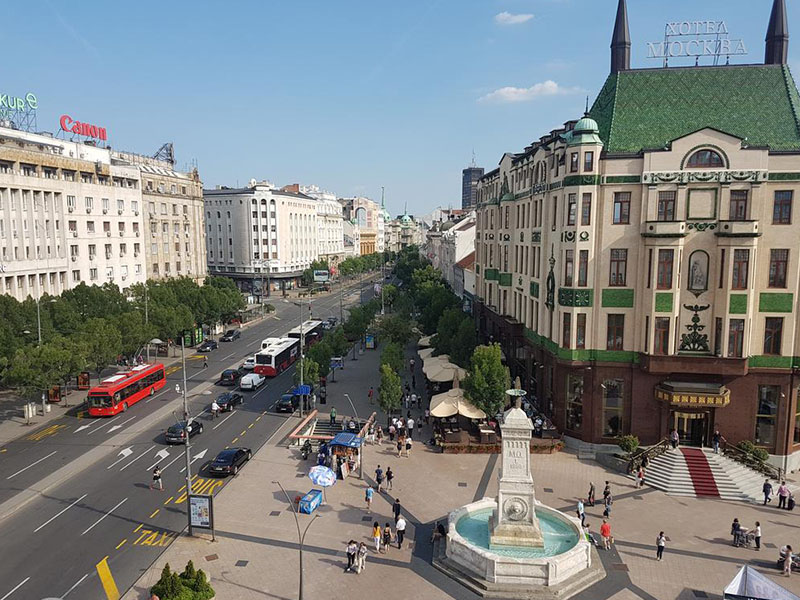The 1918 Belgrade Proclamation of a single Yugoslav state
Officially, the South Slavs (i.e., the Yugoslavs) were united into their own national single state on December 1st, 1918, when the Regent Aleksandar I Karađorđević of Serbia read the Proclamation of the Kingdom of Serbs, Croats, and Slovenes in the Krsmanović house in Belgrade Terazije square. However, this Belgrade Proclamation was, in fact, Serbia’s verification of the previous Zagreb Proclamation of the unification with certain modifications.
Legally, this Act of Union was composed of two parts:
- First of them was the Address written by the Serb from Croatia Svetozar Pribićević and the Croat from Croatia Dr. Ante Pavelić and read by the delegation of the Zagreb National Council.
- The second one was the Reply of the Crowned Prince Aleksandar I Karađorđević to the Council’s Address.
Thus, the First-December Act (1918) was a result of the final political agreement between Zagreb and Belgrade in the personalities of Serbia’s Regent and the delegation of the National Council in Zagreb in the legal form of the formal proclamation of a new state.
According to the text of the Address, the Zagreb National Council’s numerous delegation (however, without the Slovenian representatives) arrived in Belgrade as the representatives of the peoples from the following South Slavic lands in Austria–Hungary: Slovenia, Croatia, Bosnia, Banat, and Baranja asking for the unification of the State of Slovenes, Croats, and Serbs with the Kingdom of Serbia and the Kingdom of Montenegro. It is necessary to note that from Serbia’s point of view, the Serbian Government or the Regent was a representative of the whole portion of Vojvodina and Montenegro in consideration of their “union” with the Kingdom of Serbia in November 1918, as well as the biggest parts of Bosnia-Herzegovina according to their wish from the same period. This meant virtually:
- Firstly, both the Serbian authorities and the National Council in Zagreb claimed that they are representing Vojvodina and Bosnia-Herzegovina during the final stage of the process of unification.
- Secondly, according to the Regent’s Reply, the Austro–Hungarian South Slavic lands of the independent State of Slovenes, Croats, and Serbs (not internationally recognized except by the Kingdom of Serbia), united its territory with the Kingdom of Serbia (enlarged by Vojvodina, Montenegro, and the biggest portions of Bosnia-Herzegovina).
- Thirdly, both sides did not make a clear agreement concerning a territorial representation during the ultimate round of the negotiations and the final Proclamation of the common state as both of them claimed a certain number of the Yugoslav provinces as their own before the First-December Act.

In its Address, the Zagreb National Council labeled the Serbian army as a “…victorious national Army…”, which was fighting “…side by side with the Armies of our mighty Allies…”[1] In this case, the Zagreb National Council assembled itself with the Entente powers, as one of the members of the victorious side in the war that was out of historical reality. In the following part of the Address, a revolutionary secession from Austria–Hungary of the Slovenes, Croats, and Serbs was stressed, as well as the principal political consequence of this fact – the creation of their independent (self-proclaimed) national state. The Slovenes, Croats, and Serbs from former Austria–Hungary declared “that they wish and are determined to unite with Serbia and Montenegro in one joint national state of the Serbs, Croats, and Slovenes, […] to embrace all the continuous ethnographic territory of the Southern Slavs”.[2] This desire was rested on the people’s right to self-determination. Nevertheless, the most significant “hidden” point of this statement was that the Zagreb National Council’s delegation did not recognize the political unification of Montenegro and Serbia into a single state (the Kingdom of Serbia), proclaimed in Podgorica on November 26th, 1918. It was also emphasized in the next statement that the Council on “…its sitting of November 29th resolved to proclaim the union of the State of the Slovenes, Croats and Serbs with Serbia and Montenegro in one single State…”[3] At the same place, two additional points are stressed by the Zagreb National Council:
- First of all, the Zagreb National Council already proclaimed the union with Serbia.
- Second of all, for the Council’s delegation, the union of the South Slavs into a single state was made between three independent political entities; in the other words, between three independent states: 1) the State of Slovenes, Croats, and Serbs; 2) the Kingdom of Serbia; and 3) the Kingdom of Montenegro.
The first part of the Address was finished with likely the most significant paragraph within the whole text. Precisely, the Zagreb National Council’s delegation vested the Serbian King, the Prince-Regent respectively, to have “…the power of the Sovereign throughout the whole territory of the now united State…”[4] This, practically, meant that the Zagreb delegation recognized the monarchy as the state-form with the Serbian dynasty on the throne of the state. Evidently, with regards to the question upon a type of state (republic or monarchy), the Zagreb delegation of the National Council rejected decisions that were concluded in Geneva in November 1918 by itself, the London Yugoslav Committee, the Serbian Government, and the Serbian parliamentary opposition parties. Moreover, the Zagreb delegation rejected the most important requirement for the unification written in the Naputak, the document that was a written direction for the Zagreb delegation for its negotiations with Belgrade.
The policy of the Zagreb delegation in Belgrade
The Zagreb delegation of the National Council, therefore, accepted decisions signed at the Corfu Island in July 1916 by the London Yugoslav Committee and the Serbian Government-in-exile. It is important fact that the London Yugoslav Committee did not participate in the final negotiations concerning the creation of Yugoslavia in Belgrade and the creation of the text of the official Proclamation of the unification. Nevertheless, the decisions created by the London Yugoslav Committee at Corfu Island were accepted and incorporated into the final act of the unification. In other words, the Zagreb National Council’s delegation did not accomplish in Belgrade the Council’s requirements brought from Zagreb and finally signed with Belgrade the decisions agreed at the Corfu Island in July 1916 but not those agreed in Geneva in November 1918. It means that the Zagreb delegation carried out the political attitude of the London Yugoslav Committee, the organization that even was not present in Belgrade during the final stage of the negotiations,[5] about a proclamation of the Kingdom of Serbs, Croats, and Slovenes. The Zagreb delegation of the State of Slovenes, Croats, and Serbs was disrespectful towards directions in the Naputak likely because the Italian military advance into the territory of Dalmatia and Istria, but also at the same time and for the reason of a revolutionary fermentation in its own state.
The Zagreb delegation was, in fact, forced to concede to the Serbian authorities because of the external as well as the internal threats to its own state. In addition and of extreme political importance, the State of Slovenes, Croats, and Serbs by joining the Kingdom of Serbia (with Montenegro) into a united Yugoslav state would join at the same time and victorious side in WWI and, therefore, will not be further treated by the Entente states as an enemy (as a part of the Austro–Hungarian Monarchy) which should pay war reparations after the Peace Conference.[6] Anyway, these three reasons have been the most consequential for the Zagreb delegation to recognize the monarchical form of the political type of the new state with the Karađorđević dynasty on the throne. According to the Zagreb delegation’s Address, “…a single parliamentary Government shall be formed for the whole territory of the Yugoslav state, with a single representative body”[7] in agreement with the Serbian Government and the representatives of all national parties in Serbia and Montenegro. Such statement was on the line of the Naputak as the Governmental Council should be created as it was required by the National Council “…constituted by a joint agreement between the National Council and the representatives of the people of the Kingdom of Serbia…” and “…that this national representative body should remain in session until the convocation of the Constituent Assembly…”[8] In addition, the Address demanded to be established the autonomous representative bodies under the control of the central Government. Both of these requirements were stipulated on Corfu Island and Geneva.
The Zagreb delegation was speaking in Belgrade in the favour of the Constituent Assembly, “which, according to the proposal submitted by the National Council”[9] should be rested on the universal equal elections, as well as on the direct secret and proportional suffrage. The Constituent Assembly should be convoked within six months after the peace treaty is signed. Thus, voting a state constitution by the Constituent Assembly was emphasized in the Corfu and Geneva Declarations and also in the Proclamation of the State of Slovenes, Croats, and Serbs.
However, if we compare the previous declarations, proclamations, the Naputak, and the Address with each other we will notice that there are several points of both agreements and disagreements between them with regards to the question of the Constituent Assembly:
- First of all, in both declarations (Corfu and Geneva), as well as in the Proclamation of the State of Slovenes, Croats, and Serbs in Zagreb, the Constituent Assembly was envisaged as an institution, which would adopt a final version of the state constitution.
- On one hand, in the 1916 Corfu Declaration, a new state was in advance labeled as a monarchical one with the Serbian dynasty on the throne.
- Contrary, according to the Geneva Declaration and the Proclamation of the State of Slovenes, Croats, and Serbs in Zagreb in 1918, the question about republic or monarchy should be resolved by the constitution. In other words, the Constituent Assembly should make a final decision about it.[10]
- Moreover, according to the Naputak, the governmental type of the new state would be resolved by the constitution that would be voted by the Constituent Assembly.
- However, the Council’s delegation recognized in Belgrade in advance a monarchical type of the state government and, in fact, avoided both the 1918 Geneva Declaration and the 1918 Proclamation of State of Slovenes, Croats, and Serbs, as well as instructions written in the 1918 Naputak.
- In addition, the Zagreb delegation avoided and the statement that the qualified majority in the Constituent Assembly would accept the state constitution which was incorporated into the 1918 Geneva Declaration, the 1918 Proclamation of State of Slovenes, Croats, and Serbs as well as in the 1918 Naputak.
The same (military-political) reasons influenced the Zagreb delegation to reject in Belgrade both crucial requirements by the Zagreb National Council: 1) that the question upon republic or monarchy would be resolved by the Constituent Assembly; and 2) that the Yugoslav constitution would be accepted by the qualified majority of the votes.[11] Certain evidence for this assertion was given by the Zagreb delegation itself in the last paragraph of its Address to the Serbian King. Namely, the text of the Address is finished with two assertions. The first one was that the Zagreb National Council’s delegates were “…representatives of the people from the whole of the Yugoslav territory of the former Austro–Hungarian Monarchy…”[12] The second one was “…that large and precious parts of our national territory are occupied by the troops of the Kingdom of Italy…”, and finally “we cannot recognise, however, the justice of any agreement – and still less of the Pact of London…[13]
Subsequently, the conclusion is that the Council’s delegation, which was sent to Belgrade to make a final agreement with the Serbian authorities regarding the Proclamation of a new state, disrespected two of the most important Council’s requirements written in the Naputak primarily taking into account the Italian territorial aspirations towards significant portions of the State of Slovenes, Croats, and Serbs, which already have been given to Italy (the 1915 London Pact) by the Entente powers: 1) The Constituent Assembly would vote the state-constitution by the qualified majority of the voting body, and 2) The question about monarchy or republic would be resolved by the Yugoslav constitution). In other words, the Serbian authorities made good use of the hard position in which the State of Slovenes, Croats, and Serbs has been, connected with the Italian military danger, to impose its own conditions for the unification but only after Zagreb rejected an option proposed by Belgrade that a Greater Serbia and small Croatia and Slovenia would be created as independent states if the Kingdom of Serbs, Croats, and Slovenes was not going to be established according to the Serbian standards and, therefore, a significant portion of Yugoslav land populated by Slovenes and Croats was not after the Peace Conference in Paris annexed by Italy but it was included into Yugoslavia.
Why Yugoslavia and the First-December Act (1918)
As a matter of fact, the Entente powers, the National Council in Zagreb and the Royal Serbian Government needed Yugoslavia at that moment for several geopolitical reasons:
- As the best bulwark against the Germanic and the Italian domination over the Central and West Balkans.
- For the Croats, the creation of Yugoslavia was the optimal solution as it was the only option to keep together all ethnic and historical Croatian lands within a single Slavic state body.
- For the Serbs, the Croats and Slovenes should play a role of a mediator with the Roman Catholic Church in the future.
- The Croats saw Serbs as lesser enemies as the Austrians or Hungarians have been, while the Serbs thought that the Croats would be lesser dangerous for the Serbdom if Croatia would be included in Yugoslavia rather than to be an independent state (which could ally with Bulgaria against Serbia).
- Finally, the Serbian Government was aware that the main political problem in the new Yugoslav state (or a Greater Serbia in accordance to the Croatian perception)[14] would be to “amortize” the Croatian separatism and republicanism.

The unification of almost all South Slavic peoples into their own national single state was virtually proclaimed by the Regent Aleksandar I Karađorđević in his Reply to the Address (read by the delegation of the State of Slovenes, Croats, and Serbs) on December 1st, 1918.[15] In the first place in his own Reply to the Address, “his Royal Highness Crown Prince Aleksandar” recognized the Zagreb delegation as a representative body of the National Council of Slovenes, Croats, and Serbs in Zagreb. This meant that the Kingdom of Serbia, in the final act of union, reaffirmed its own decision concerning the acknowledgment of “the National Council in Zagreb as the legal Government of Serbs, Croats, and Slovenes who live on the territory of the Austro–Hungarian Empire” in Geneva on November 8th, 1918.[16] According to a Croat Ferdo Šišić, the Royal Serbian Government recognized the National Council in Zagreb “… as the legal Government of the Yugoslav countries of the former Austro–Hungarian Empire”[17] before the official Proclamation of the new state was made.
However, the real political question remained which territories of the Yugoslavs are recognized by Belgrade to be included in the State of Slovenes, Croats, and Serbs before the First-December Act (1918) was read? Nevertheless, a legal consequence of that was the fact that a new state was proclaimed as “the union of Serbia with the lands of the independent State of the Slovenes, Croats and Serbs in the United Kingdom of the Serbs, Croats and Slovenes”.[18] Consequently, the Kingdom of Serbs, Croats, and Slovenes was created officially and legally through the unification of two independent states – the Kingdom of Serbia (including Montenegro, Vojvodina, and the biggest part of Bosnia-Herzegovina) and the State of Slovenes, Croats, and Serbs, whose independence was recognized only by Serbia. That a new state of Yugoslavia was created through the unification of two independent states, from a legal point of view, can be seen in two official Proclamations, concerning the union, issued by both political actors. The first of them was a conclusion of the evening session of the National Council in Zagreb that was made on November 23rd, 1918, when the “Proclamation by the National Council of the unification of the State of Slovenes, Croats and Serbs with the Kingdom of Serbia and Montenegro”[19] was issued. The second one was the “Official Proclamation of the union of the Kingdom of Serbia and Montenegro with the State of the Slovenes, Croats and Serbs”,[20] adopted by the Serbian parliament at its 98th ordinary sitting in Belgrade on December 29th, 1918.
Finally, we can conclude that the Zagreb delegation did not respect, in its Address to the Regent, the unification of Serbia and Montenegro into one centralized state, which was done on November 26th, 1918 under the name of the Kingdom Serbia but preferred to understand the same unification on a federal basis (the Kingdom of Serbia and Montenegro).
According to the text of the final Proclamation of the Kingdom of Serbs, Croats, and Slovenes (December 1st, 1918), a new state would be established on the “constitutional, parliamentary and broad democratic principles, based on universal suffrage”,[21] which was in concordance with all previous proclamations and declarations, as it was the case with the statement that the transitional and provisional period of the state would last until the Great Constitutional Assembly’s convocation when the final state-constitutional arrangement would be adopted. However, in the Proclamation of the unification in Belgrade (December 1st, 1918) the following two crucial the Zagreb National Council’s requirements, concerning the Constituent Assembly, were avoided:
- The inner state-form would be decided by the Constituent Assembly.
- The constitution would be accepted by the qualified (two-thirds?) majority of the voting body.

In other words, in the Proclamation on December 1st, 1918 the last point even was not mentioned at all. However, the first point was resolved in advance in favor of a monarchical type of the state, as we can see in the following part of the Proclamation of the Kingdom of Serbs, Croats, and Slovenes: “true to the example and advice given me [to Aleksandar Ist] by my august father [Petar Ist], I will be King only of the free citizens of the State of the Serbs, Croats and Slovenes, …”[22] In addition, the Proclamation was ended with mentioning the name of a new state: the Kingdom of the Serbs, Croats, and Slovenes, what was in a contrast to the ending of the Address in which the new state was named as united Yugoslavia.[23] Obviously, regarding the name of a state, the formula of “three-names nation” (Serbs-Croats-Slovenes), promoted by the Serbian Government, particularly by its Prime Minister, was accepted at the expense of the Council’s attitude towards the state name as Yugoslavia. The name of Yugoslavia, as the state name, was rejected by Belgrade for two principal reasons:
- The terms Yugoslavia and the Yugoslavs are created by the Habsburgs against the Serbian national interest.
- The Serbian Government wanted to preserve the Serbian national name in the name of the new state.
Concluding words
Finally, the Proclamation of the Yugoslav unification was ended with two significant points:
- Firstly, the representatives of two sides would compose the Government, which would rule the country during the provisional period: the Serbian Government and the Zagreb National Council (that was foreseen also in the previous declarations and proclamations). Nevertheless, in comparison with the Naputak, the representatives of the London Yugoslav Committee (five members) were not anticipated to participate in this provisional Government.[24]
- Secondly, “this Government will assume as its first duty that of securing that the frontiers of our State are drawn following the ethnographic boundaries of our entire race”.[25]
This written statement in the ultimate legal act of the Proclamation of a new state was made as Serbia’s compensation to Zagreb for the reason that the Council’s delegation accepted the monarchical type of the state in advance. As it was presented in the last part of the Proclamation from December 1st, 1918, this statement was issued versus “… the realisation of the terms of the Treaty of London, signed without us and never recognised by us …”[26]
Shortly, the Kingdom of Serbia assumed to defend the territory of the State of Slovenes, Croats, and Serbs against the Italian territorial aspirations but also to try to include and Slovenian populated lands of the Austrian southern province of Carniola into the Kingdom of Serbs, Croats, and Slovenes.[27]
Reposts are welcomed with the reference to ORIENTAL REVIEW.
Endnotes:
[1] Snežana Trifunovska, Yugoslavia Through Documents From its creation to its dissolution, Catholic University Nijmegen, Martinus Nijhoff Publishers: Dordrecht/Boston/London, 1994, “Proclamation of the Kingdom of Serbs, Croats and Slovenes”, pp. 157–160.
[2] ibid.
[3] ibid.
[4] ibid.
[5] About the meaning and the procedure of the term and the process of diplomatic negotiations in international affairs and foreign policy, see in [G. R. Berridge, Lorna Lloyd, The Palgrave Macmillan Dictionary of Diplomacy, Third Edition, New York: Palgrave Macmillan, 2012, pp. 257‒258].
[6] Ferdo Šišić, Dokumenti o postanku Kraljevine Srba, Hrvata i Slovenaca (1914–1918), Zagreb, 1920, pp. 246–248; Milan Đorđević, Srbija i Jugosloveni za vreme rata 1914–1918, Beograd, 1922, p. 244; Peter Vodopivec, Od Pohlinove slovnice do samostalne države. Slovenska zgodovina od konca 18. do konca 20. stoletja, Ljubljana, 2006, p. 166. According to Jovan Banjanin, a member of the Yugoslav Committee in London, Croatia at the moment had only one option that was to join Yugoslavia in order to avoid its own territorial division between Serbia, Italy, Austria, and Hungary after the war (Lučonoša, “Londonski sporazum i hrvatsko pitanje”, Zagreb, 1946, p. 7). The ultra-right Croatian Party of Rights ideologically “justified” Croatian joining Yugoslavia under the rule of the Serbian royal dynasty by the explanation that the Serbian/Yugoslav King, is a Croat as all Serbs in ethnolinguistic point of view are just the Orthodox Croats [Hrvatska država, November 16th, 1918].
[7] Snežana Trifunovska, Yugoslavia Through Documents From its creation to its dissolution, Catholic University Nijmegen, Martinus Nijhoff Publishers: Dordrecht/Boston/London, 1994, “Proclamation of the Kingdom of Serbs, Croats and Slovenes”, pp. 157–160.
[8] ibid.
[9] ibid.
[10] Many Bosnian Muslims and Croats supported a republican type of state but not a monarchical one. Thus, according to the reports, when the Serbian army entered Sarajevo in November 1918 some citizens shouted “Viva Republica”.
[11] What does it mean a “qualified majority” is not specified in any mentioned document concerning the creation of Yugoslavia. However, the majority of our days contemporary political scientists are sharing an opinion that a “qualified majority” is two-thirds but not half votes of the voting body. According to them, half the votes of the voting body is an “absolute majority” while the only the majority of votes is a “simple majority”. However, a “qualified majority” can be understood as ¾ of the voting body [see more in: Keith Dowding, Encyclopedia of Power, SAGE Publications, Inc., 2011].
[12] Snežana Trifunovska, Yugoslavia Through Documents From its creation to its dissolution, Catholic University Nijmegen, Martinus Nijhoff Publishers: Dordrecht/Boston/London, 1994, “Proclamation of the Kingdom of Serbs, Croats and Slovenes”, pp. 157–160.
[13] ibid.
[14] Ivo Goldstein, Croatia. A History, London, 1999, 108–130; Dragutin Pavličević, Povijest Hrvatske. Drugo, izmijenjeno i prošireno izdanje, Zagreb, 2000, pp. 331–344; Ivo Perić, Povijest Hrvata, Zagreb, 1997, pp. 218–232.
[15] The first great power who recognized the new Yugoslav state was the USA (in February 1919).
[16] Ferdo Šišić, Dokumenti o postanku Kraljevine Srba, Hrvata i Slovenaca (1914–1918), Zagreb, 1920, p. 233.
[17] ibid.
[18] Snežana Trifunovska, Yugoslavia Through Documents From its creation to its dissolution, Catholic University Nijmegen, Martinus Nijhoff Publishers: Dordrecht/Boston/London, 1994, pp. 157–160.
[19] Ferdo Šišić, Dokumenti o postanku Kraljevine Srba, Hrvata i Slovenaca (1914–1918), Zagreb, 1920, p. 274.
[20] Snežana Trifunovska, Yugoslavia Through Documents From its creation to its dissolution, Catholic University Nijmegen, Martinus Nijhoff Publishers: Dordrecht/Boston/London, 1994, pp. 161–163.
[21] ibid.
[22] ibid.
[23] Nevertheless, the state name was changed in the Kingdom of Yugoslavia in January 1929.
[24] Interestingly, only its President had a political post (the Minister of Foreign Affairs) in the new state among all main members of the London Yugoslav Committee.
[25] Snežana Trifunovska, Yugoslavia Through Documents From its creation to its dissolution, Catholic University Nijmegen, Martinus Nijhoff Publishers: Dordrecht/Boston/London, 1994, 160
[26] ibid.
[27] On October 10th, 1920, a plebiscite was held in Carniola on which the majority of the local Slovenes decided to live in the Republic of Austria but not in the Kingdom of Serbs, Croats, and Slovenes. In the inter-war period, ¼ out of all ethnic Slovenes did not live in the Kingdom of Serbs, Croats, and Slovenes/Yugoslavia [Janko Prunk, Kratka zgodovina Slovenije, Ljubljana, 2002, p. 94].














Comments